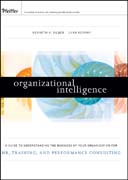
Organizational intelligence: a guide to understanding the business of your organization for HR, training, and performance consulting
Silber, Kenneth
Kearny, Lynn
The book follows the Organization Intelligence Model, which contains seven constructs that define various components of organizational performance (called Logics) that are necessary for organizational function and success. Each construct contains a number of metrics on which an organization can measure its performance as well as sample data to be collected. The Logics include External Logic, Economic Logic, Strategy Logic, Customer Logic, Product Logic, Process Logic, and Internal Logic. An example: for Process Logic, sample metrics might include RBusiness Logic section provide a menu of possible measures. By partnering with their clients and/or other experts in the organization, Training/HPT/ID/OD/HR practitioners can identify which of these measures are used by the organization to track its performance. They can use this information to construct a scorecard of key metrics in the organization as it currently is operating, and as management would like it to operate. These metrics then form the basis of the first process in any Training/HPT/ID/OD/HR model the organization gapor needs or analysis. Usually these analyses are conducted in isolation or inthe language of the Training/HPT/ID/OD/HR practitioner. The Organization Intelligence Model provides a way to do a gap analysis which is holistic and systemic, addressing all the gaps in the organization and how they impact one another.
- ISBN: 978-0-470-47231-6
- Editorial: John Wiley & Sons
- Encuadernacion: Cartoné
- Páginas: 320
- Fecha Publicación: 11/12/2009
- Nº Volúmenes: 1
- Idioma: Inglés
